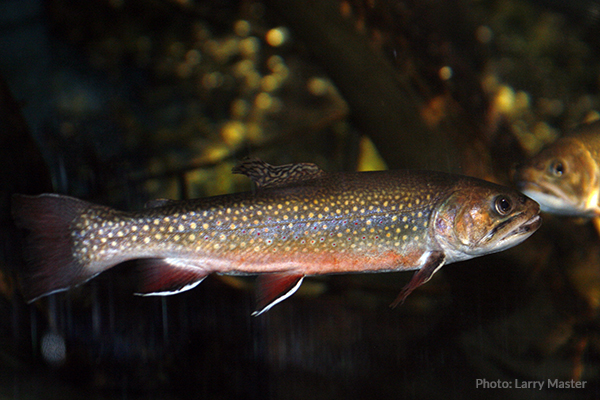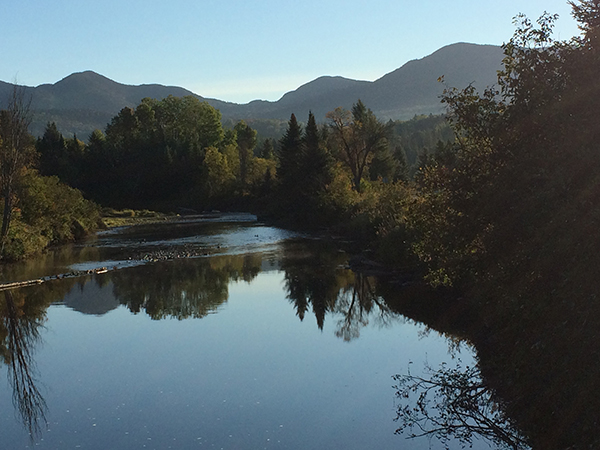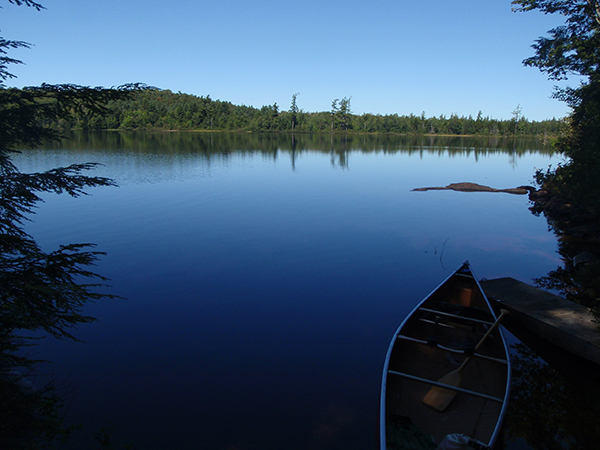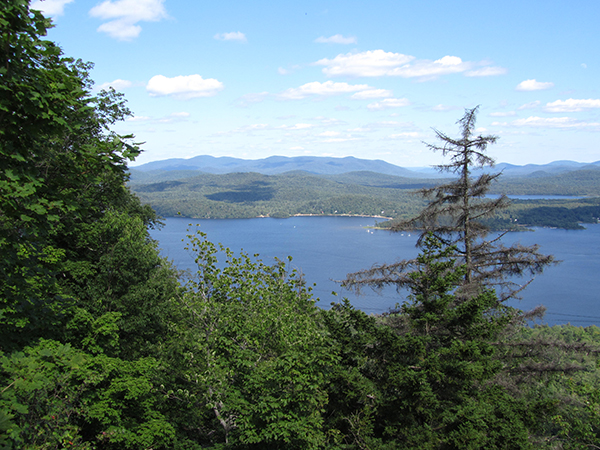
Fate of Brook Trout Tied to (March 27) Federal Budget Deadline
By: John Sheehan - Adirondack Council Director of Communications
Wednesday, March 14, 2018
“April is the cruelest month,” wept T.S. Elliot in the first stanza of The Waste Land. If he had seen this year’s federal budget proposal, he’d have known it’s really March.
Congress is poised to make deep cuts to federal programs that protect the Adirondack Park from acid rain. Congress is threatening the progress we have made in saving our 11,000 lakes and ponds, our 30,000 miles of brooks and streams – our loons, trout and wildlife -- from acid rain. Nothing could be crueler than that.
 Photo: Larry Master
Photo: Larry Master
Today’s partisan and divided Congress won’t even attempt to pass a budget bill that requires cooperation between the two major parties. Instead, Congress has approved a series of “continuing resolutions” that allow current funding levels to continue for a set period of time, until a formal budget bill can be passed.
The current continuing resolution expires on March 27.
Prior to that next government-shutdown deadline, Congress plans to approve a two-year budget resolution that contains deep cuts to the U.S. Environmental Protection Agency (EPA). President Donald Trump has proposed a cut of 31 percent. The House is proposing a 16 percent cut. Either would destroy the EPA’s acid rain program. That would be especially bad for the Adirondack Park.
Clean Water = Public Health
Protecting clean water and public health is good for everyone and everything. Our wilderness, wildlife, people and communities all fare better with clean, healthy air and pure water. Without the EPA, we can have neither.
I am saddened by the fact that the EPA has been a convenient punching bag for any pol who wanted to sound like she/he had a pro-business agenda. Thus, it has been easy to starve it of the resources it needs to carry out its mission. Over the decades, EPA’s mission has expanded, but its budget hasn’t kept pace. That’s a backdoor way of negating clean air laws that Congress has already approved. We need a new investment in the environment from Congress instead.
The EPA and Adirondack Brook Trout
Here in the Adirondacks, we can point to the EPA as the only reason we still have any brook trout alive in our waters. EPA is also the reason that some long-lost native brook trout are now coming back to us.
Nearly every year now, we hear reports of new life emerging in trout waters that were once too damaged by acid rain to support their native life. The state record brookie now hails from Silver Lake, in the Silver Lake Wilderness Area. Just imagine: a six-pound, 22.6 inch leviathan from an Adirondack lake that was once too sour for trout.
Trophy fish are appearing in places where the water once was clear as gin, stripped even of its plants and algae by acidic rain, snow, fog and soot. Heritage strains of brookies once thought to be extinct are emerging from headwater streams to repopulate formerly dead lakes and ponds.
Pruitt Not Enforcing Pollution Control
That trend could soon come to an end under the Trump administration. With the president’s encouragement, the Congress is slated to slash the EPA’s budget. Worse, Trump’s EPA Administrator Scott Pruitt is quietly dismantling the agency from within. Pruitt was once the attorney general of Oklahoma, where he made a career by suing the EPA to delay clean air rules on behalf of that state’s fossil fuel industry. Now, he is delaying them by refusing to act when smoke from the dirtiest coal-fired Midwest power plants causes smog and acid rain in the Northeast.
From the final two years of the George W. Bush administration through the Obama administration, the EPA’s Cross-State Air Pollution Rule has been enforced. The rule recognizes that dirty air doesn’t remain where it is emitted. It drifts “away.” For the Midwest, “away” means the forests, lakes and cities of the Northeast. So, no matter how tough a Northeast state’s air pollution rules might be, they can be foiled by weak rules in Midwest states.
Midwest Coal Pollution Means Adirondack Acid Rain
Over the past decade, EPA’s enforcement of the rule has dramatically reduced the smokestack pollution falling on the Northeast. That has meant less acid rain damage and far fewer illnesses and deaths from smog and soot, from Maine to Maryland. 
There is no doubt of this. EPA requires 24-hour-a-day emissions monitoring on smokestacks. EPA pays for air and water testing in the Adirondacks to confirm the results of the emissions reductions. We know what goes up and where it comes down. We know how many people go to the hospital, doctor and pharmacy for lung ailments. We know how many people miss work or school or can’t visit a tourism-dependent area when the air is bad.
In the past, some members of Congress tried to delay EPA’s clean air rules by forcing the agency to conduct cost-benefit studies. Those studies backfired on EPA’s critics. They proved that the nation saved $20 in human health costs alone for every $1 spent by industry complying with clean air rules.
Because of EPA-funded monitoring, we all know which states needed to make the deepest cuts. EPA offered incentives to make those cuts happen quickly. In the Adirondacks, the results have been dramatic. All life forms that haven’t been wiped out (some have) can begin to repopulate our waters again as conditions improve.
New York Can't Fight Acid Rain Alone
New York could not have accomplished this on our own. We tried. We passed the first acid rain laws in the nation in 1983. Vermont and Minnesota followed. Most Midwest states didn’t. Instead, they built taller smokestacks. Most of their smoke went “away.” Today, about 80 percent of the sulfur-based air pollution and 70 percent of the nitrogen-based air pollution harming the Adirondacks comes from outside of New York, where our laws don’t apply.
It took Congress until 1990 to create a national program, which EPA commenced in 1995. It was a good start, but wasn’t enough to solve the entire problem. How do we know? Because some of the best scientists in the world conduct research here to keep tabs on the impacts of water chemistry and air pollution.
Adirondack Research Pushes Progress
In New York, this research is overseen by the NYS Energy Research and Development Authority. NYSERDA coordinates with major universities and not-for-profit partners around the state. Together, they stretch thin budgets wide enough to keep track of EPA’s progress – or the lack thereof.

For example, a NYSERDA-supervised study found that future researchers won’t need to haul huge batteries, cables and fish nets into the backcountry to test for the presence of brook trout in remote streams. Instead, it created a method of testing stream water for the presence of trout DNA that will save countless hours and dollars in the years ahead, while providing reliable information. Best of all, no one needs to stun hundreds of trout with electrical current to determine if they exist.
Another recent study showed that curbing the effects of acid rain aids lakes in sheltering brook trout from global warming. Allowing green plants, suspended algae and other aquatic life to recover from acid rain allowed lakes to regain a cold-water layer at the bottom. Tiny aquatic organisms cloud the water just enough to prevent sunlight from penetrating to the bottom. This keeps the deepest parts of the lake cool, even in the hottest days of summer. This protects trout and other species that cannot live in waters that warm beyond the mid-60s Fahrenheit.
There are dozens more examples of research that advances our understanding of the Adirondack Park’s watersheds, forests, wildlife, climate, and soil chemistry. All of this adds up to recovery of our fisheries. It means we can all look forward to a day when native Adirondack trout are plentiful and healthy, and free from the mercury contamination that acid rain worsens. But Congress fails year after year to appropriate adequate funding for this research, forcing NYSERDA and others to choose between what is best and what is still possible.
This tendency to short-change science will only get worse if Congress cuts the EPA’s budget. The Adirondack Council has asked the New York Congressional delegation to stand up for EPA’s budget. We have asked those in power to increase EPA’s funding for acid rain research. Keep your eye on that March 29 deadline.

Final Note
Also, in March or April, keep an eye peeled for a federal court decision on our lawsuit against EPA Administrator Pruitt. We joined the State of Maryland (as well as the Environmental Defense Fund, Chesapeake Bay Foundation and others) to sue him for refusing to order Midwest power plants to turn on already-installed pollution controls when smog made the Northeast’s air unhealthy last summer. Summer heat and sunlight turn the same pollutants that cause acid rain into smog. EPA studies show that its smog regulations prevent 20,000 American illnesses and pre-mature deaths per year. Most of those illnesses and death occur in the Northeast, where power plant emissions are lowest but where interstate transport of air pollution is highest.
No previous administrator had refused such a petition under the Clean Air Act. His most recent filings requested until Dec. 31, 2018 to answer why he refused to act in the summer of 2017. Plaintiffs took this as a signal he would refuse to act in the summer of 2018 as well.
At the same time he is facing criticism for extraordinarily high office, travel and security expenses, Pruitt claimed EPA would have to divert money from regulatory programs in order to comply with the court’s request for an answer. Imagine all the rules he won’t want to enforce if the EPA’s budget is cut further!
Take Action!
Here's how you can help. Please write to Senators Schumer and Gillibrand and ask them to stand firm on no cuts to the EPA budget. Ask for their support on funding for Adirondack water testing and air quality monitoring grants that are part of the EPA Office of Air & Radiation, Clean Air Markets Division, Science and Technology grants program.
Write your letter to stand up for Adirondack programs today!
|





